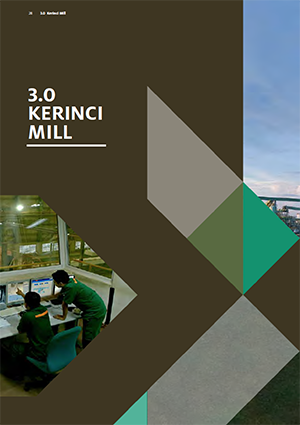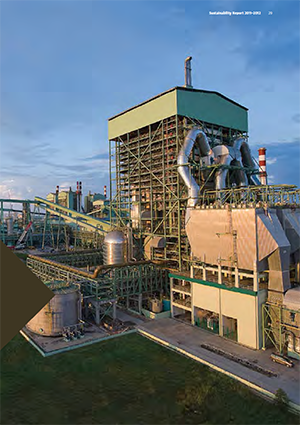Efficient Use of Energy and Materials
Figure 9: TOTAL FUEL ENERGY CONSUMPTION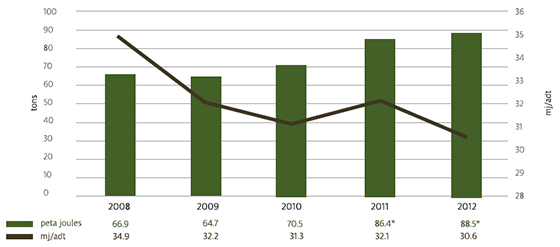
Decreased energy consumption per ADT
The graph in Figure 9 above shows total fuel energy consumption from 2008 to 2012. Since our 2010 Sustainability Report, improved efficiency and asset utilisation has resulted in better environmental performance.
This can be seen in the decrease in energy and materials required to produce one tonne of mill output (mj/adt).
This trend toward greater efficiency is evident in much of the data presented in this section of this Report.
Figure 10: ENERGY CONTRIBUTION BY FUEL SOURCE, 2011-2012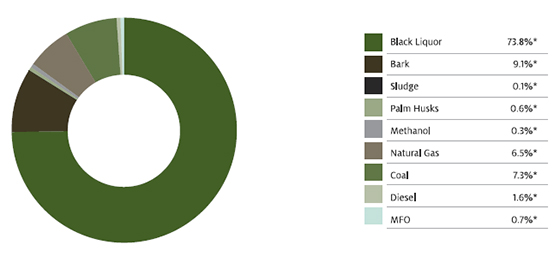
Return on Investment from Environmental Initiatives
APRIL operates an ongoing program of investing in projects that improve our environmental performance. During the 2011-2012 reporting period, a number of these projects reached their full potential, delivering solid returns on our investment.
Figure 10 above shows energy contribution by fuel source. Of our total energy consumed, 85 per cent* now comes from biofuel, with the largest component contributed by our recently built recovery boiler.
The commissioning of Recovery Boiler Number 5 to capture energy from black liquor, (a product of Kraft pulp making) greatly increased our use of biofuel for power generation.
As one of the world’s largest recovery boilers, this facility has allowed us to debottleneck our pulp production, thereby reducing our reliance on fossil fuels and cutting the indirect, transport related impacts of these fuels as well as reducing emissions from fossil fuels.
Recovery Boiler Number 5 now contributes a significant amount of our mill’s energy requirements. The energy it and two older recovery boilers generate is used to produce steam for power generation and for drying pulp and paper. The boiler also recovers chemicals for reuse in pulp making.
An additional 10 per cent* of our energy comes from biomass such as bark, sludge, palm husks and methanol.
More Fuel Captured from Waste
Figure 11: METHANOL CAPTURED FROM EVAPORATORS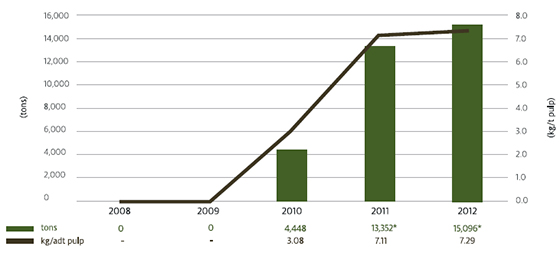
The graph in Figure 11 above shows that our methanol capture project has reached designed capacity. APRIL can now capture significant volumes of methanol from weak black liquor through a process of evaporation and distillation. This valuable biofuel is reused in our lime kilns, replacing fossil fuel.
Since our last Sustainability Report, methanol production has been ramped up from 4,000 to 15,000 tonnes per year, further reducing dependence on fossil fuels, particularly marine fuel.
Reducing Wood Fibre Content Through Capture and Use of Waste CO2
APRIL has entered into a joint venture partnership with the developer of technology related to the use of precipitated calcium carbonate (PCC) as a filler in paper.
PCC reduces the need for wood fibre, while allowing paper to retain desired characteristics such as stiffness and smoothness.
Our PCC plant combines calcium hydroxide with waste CO2 that is captured from our lime kilns. As an integrated pulp mill, we use lime kilns to convert calcium carbonate to calcium oxide or "quicklime." This process generates a significant amount of CO2.
Rather than emit this gas as a waste, we capture a portion of it to produce calcium carbonate on site. The result is that around 40% of the calcium carbonate filler in our paper originates as waste CO2.
Another successful project involves a reduction in the amount of bleached soft wood kraft (BSWK) we require. BSWK is used to add strength to paper during papermaking. However, the addition of a strengthening compound during papermaking has decreased our consumption of BSWK by around 25,000 tonnes compared with 2009.
This BSWK is imported from Chile, so the reduction represents a meaningful decrease in indirect, transport related CO2 emissions.
Reduced Material Imports
Figure 12: IMPORTED BLEACHED SOFT WOOD KRAFT [BSWK] USAGE FOR PAPER![Imported Bleached soft wood kraft [BSWK] Usage for paper Imported Bleached soft wood kraft [BSWK] Usage for paper](/sr2012/images/imported-bleached-soft-wood-kraft-bswk-usage-for-paper.jpg)
Maximising Valuable Fibre Resources
Figure 13: PIN CHIP PULP PRODUCTION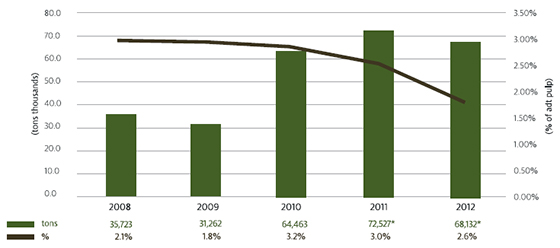
Our investment in a pin chip digester and chip classification screens continues to prove valuable in waste prevention and resource maximisation. Fine wood particles that were previously used for fuel are now captured by a fine chip classification system.
Instead of burning, this valuable wood fibre resource is then converted to pulp. The volume of pin chips recovered in the last two years equates to around 560,000 tons of pulp-logs.
Protecting Forest Soil and Reducing Transport Emissions
Our multi million dollar investment in mechanical harvesting and debarking, which included the hiring and training of new teams, has delivered a number of benefits. By leaving biomass on the forest floor, we reduce soil erosion.
As de-barked timber dries more quickly and weighs less, we significantly reduce fuel consumption and emissions associated with transporting this timber to our mill.
